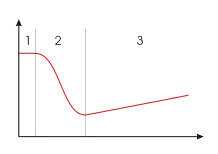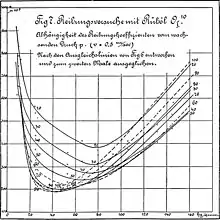Stribeck curve
The Stribeck Curve is a fundamental concept in the field of tribology. It shows that friction in fluid-lubricated contacts is a non-linear function of the contact load, the lubricant viscosity and the lubricant entrainment speed. The discovery and underlying research is usually attributed to Richard Stribeck[1][2][3] and Mayo D. Hersey,[4][5] who studied friction in journal bearings for railway wagon applications during the first half of the 20th century; however, other researchers have arrived at similar conclusions before.
Concept

For a contact of two fluid-lubricated surfaces, the Stribeck curve shows the relationship between the so-called Hersey number, a dimensionless lubrication parameter, and the friction coefficient. The Hersey number is defined as:
where η is the dynamic viscosity of the fluid, N is the entrainment speed of the fluid and P is the normal load per length of the tribological contact. Hersey's original formula uses the rotational speed (revolutions per unit time) for N and the load per projected area (i.e. the product of a journal bearing's length and diameter) for P. Thus, for a given viscosity and load, the Stribeck curve shows how friction changes with increasing velocity. Based on the typical progression of the Stribeck curve (see right), three lubrication regimes can be identified.
- Boundary lubrication
- Solid surfaces come into direct contact, load supported mainly by surface asperities, high friction
- Mixed lubrication
- Some asperity contact, load supported by both asperities and the liquid lubricant.
- Hydrodynamic lubrication
- Negligible asperity contact, load supported mainly by hydrodynamic pressure.
History

Richard Stribeck's research was performed in Berlin at the Royal Prussian Technical Testing Institute (MPA, now BAM), and his results were presented on 5 December 1901 during a public session of the railway society and published on 6 September 1902. Similar work was previously performed around 1885 by Adolf Martens at the same institute,[6] and also in the mid-1870s by Robert Henry Thurston[7][8] at the Stevens Institute of Technology in the U.S. The reason why the form of the friction curve for liquid lubricated surfaces was later attributed to Stribeck – although both Thurston and Martens achieved their results considerably earlier – may be because Stribeck published his findings in the most important technical journal in Germany at that time, Zeitschrift des Vereins Deutscher Ingenieure (VDI, Journal of German Mechanical Engineers). Martens published his results in the official journal of the Royal Prussian Technical Testing Institute, which has now become BAM. The VDI journal provided wide access to Stribeck's data and later colleagues rationalized the results into the three classical friction regimes. Thurston did not have the experimental means to record a continuous graph of the coefficient of friction but only measured it at discrete points. This may be the reason why the minimum in the coefficient of friction for a liquid-lubricated journal bearing was not discovered by him, but was demonstrated by the graphs of Martens and Stribeck.
The graphs plotted by Martens show the coefficient of friction either as a function of pressure, speed or temperature (i.e. viscosity), but not of their combination to the Hersey number. Schmidt[9] attempts to do this using Marten's data. The curves' characteristic minima seem to correspond to very low Hersey numbers in the range 0.00005-0.00015.
References
- Stribeck, R. (1901), Kugellager für beliebige Belastungen (Ball Bearings for any Stress), Zeitschrift des Vereins Deutscher Ingenieure 45.
- Stribeck, R. (1902), Die wesentlichen Eigenschaften der Gleit- und Rollenlager (Characteristics of Plain and Roller Bearings), Zeit. des VDI 46.
- Jacobson, Bo (November 2003). "The Stribeck memorial lecture". Tribology International. 36 (11): 781–789. doi:10.1016/S0301-679X(03)00094-X.
- Hersey, M. D. (1914), The Laws of Lubrication of Horizontal Journal Bearings, J. Wash. Acad. Sci., 4, 542-552.
- Biography of Mayo D. Hersey
- Woydt, Mathias; Wäsche, Rolf (2010-05-12). "The history of the Stribeck curve and ball bearing steels: The role of Adolf Martens". Wear. 268 (11): 1542–1546. doi:10.1016/j.wear.2010.02.015.
- Robert H. Thurston, Friction and lubrication - Determination of the laws and coefficients of friction by new methods and with new apparatus, Trübner and Co., Ludgate Hill, London, 1879
- Robert H. Thurston, A treatise on friction and lost work in machinery and millwork, Wiley, New York, 1894, 5th Edition
- Schmidt, Theo (2019-12-21). "Stribeck Curves" (PDF). Human Power eJournal. 11 (27).